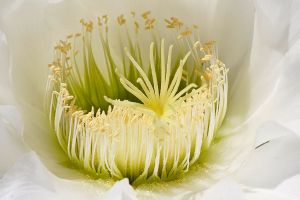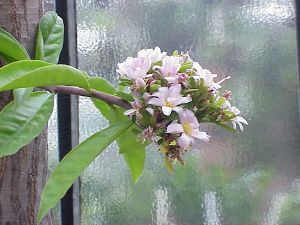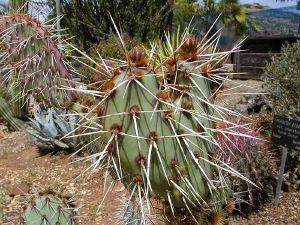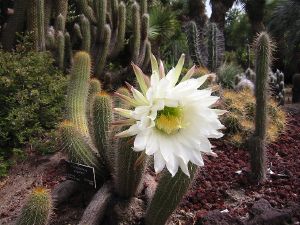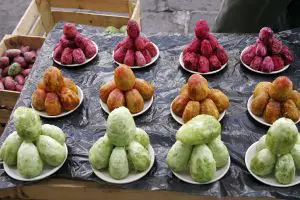Cactus
| Cacti | ||||||||||
|---|---|---|---|---|---|---|---|---|---|---|
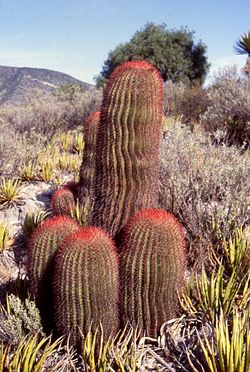 Ferocactus pilosus (Mexican Lime Cactus) growing south of Saltillo, Coahuila, northeast Mexico
| ||||||||||
| Scientific classification | ||||||||||
|
A cactus (plural cacti, cactuses or cactus) is any member of the plant family Cactaceae, native to North and South America.
Cacti are distinctive and unusual plants, most of which are adapted to extremely arid and hot environments, showing a wide range of anatomical and physiological features which conserve water. Their stems have expanded into green succulent structures containing the chlorophyll necessary for life and growth, while the leaves have become the spines for which cacti are so well known.
Etymology
The word cactus is ultimately derived from Greek Κακτος kaktos, used in classical Greek for a species of spiny thistle, possibly the cardoon, and used as a generic name, Cactus, by Linnaeus in 1753 (now rejected in favor of Mammillaria). There is some dispute as to the proper plural form of the word; as a Greek loan into English, the correct plural in English would be "cactoi" or "cactuses". However, as a word in Botanical Latin (as distinct from Classical Latin), "cactus" would follow standard Latin rules for pluralization and become "cacti", which has become the prevalent usage in English. Regardless, cactus is popularly used as both singular and plural, and is cited as both singular and plural by the Random House Unabridged Dictionary (2006).
Description
The family of the Cactaceae with approx. 2,000-3,000 species and varieties in about 60 genera was originally native to the North and South American continents, where their range extends from Patagonia to the Canadian–United States border. They are also found on nearby islands. Cacti inhabit the most diverse regions, from coastal plains to high mountain areas, from the sub-tropics to the deserts. The most dense occurrence of cactuses is to be found in the territories around north Mexico and the southern tropic (Argentina and Bolivia). The equivalent plants to cactuses in Africa and Australia are representatives of the so-called "other succulents".
There is however one exception, Rhipsalis baccifera; this species has a pantropical distribution, occurring in the Old World tropical Africa, Madagascar and Sri Lanka as well as in tropical America. This plant is thought to be a relatively recent colonist in the Old World (within the last few thousand years), probably carried as seeds in the digestive tracts of migratory birds. Many other cacti have become naturalized to similar environments in other parts of the world after being introduced by humans.
Cacti come in a wide range of shapes and sizes. The tallest is Pachycereus pringlei of northern Mexico, with a maximum recorded height of 19.2 meters (63 feet) (Salak 2000) and the smallest is Blossfeldia liliputiana of South America, which is only about 1 cm (0.4 inches) in diameter at maturity (Mauseth 2007). The smallest cacti grow almost completely underground or in the cracks between rocks. Most are medium-sized and are considered shrubs, while the largest are considered trees. Some cacti grow on the branches of trees.
Adaptations to dry environment
Some environments, such as deserts, semi-deserts and dry steppes, receive little water in the form of precipitation. Plants that inhabit these dry areas are known as xerophytes, and many of them are succulents, with thick or reduced, "succulent", leaves. Apart from a very few exceptions (for example, the genus "Rhodocactus") all cactuses are succulent plants, although not all succulent plants are cacti. Like other succulents, these cacti have a range of specific adaptations that enable them to survive in these environments.
Cacti have never lost their leaves completely; they have only reduced the size so that they reduce the surface area through which water can be lost by transpiration. In some species the leaves are still remarkably large and ordinary while in other species they have became microscopic but they still contain the stomata, xylem and phloem. Certain cactus species have also developed ephemeral leaves, which are leaves that last for a short period of time when the stem is still in his early stages of development. A good example of a species that have ephemeral leaves is the Opunta ficus indicia better known as the prickly pear. Cactus have also developed spines which allow less water to evaporate through transpiration by shading the plant, and defend the cactus against water-seeking animals. The spines grow from specialized structures called areoles. In some cacti the spines on the lower part of the plant grow downwards to prevent rodents and other animals from climbing. Spines can also collect dew from the air letting it drip down to be collected by the roots (Benson 1969).
In most cacti enlarged stems carry out photosynthesis and store water. Much like many other plants that have waxy coatings on their leaves, Cacti often have a waxy coating on their stems to prevent water loss. This works by preventing water from spreading on the surface and allowing water to trickle down the stem to be absorbed by the roots and used for photosynthesis. The bodies of many cacti have become thickened during the course of evolution, and form water-retentive tissue and in many cases assume the optimal shape of the sphere (combining highest possible volume with lowest possible surface area). By reducing its surface area, the body of the plant is also protected against excessive sunlight.
Most cacti have a short growing season and long dormancy. For example, a fully-grown saguaro cactus (Carnegiea gigantea) can absorb up to 3,000 liters of water in ten days. This is helped by cacti's ability to form new roots quickly. Only two hours after rain following a relatively long drought the formation of new roots begins. Apart from a few exceptions an extensively ramified root system is formed, which spreads out immediately beneath the surface. The salt concentration in the root cells is relatively high, so that when moisture is encountered, water can immediately be absorbed in the greatest possible quantity.
But the plant body itself is also capable of absorbing moisture (through the epidermis and the thorns), which for plants that are exposed to moisture almost entirely, or indeed in some cases solely, in the form of fog, is of the greatest importance for sustaining life.
Most cacti have very shallow roots that can spread out widely close to the surface of the ground to collect water, an adaptation to infrequent rains; in one examination, a young saguaro only 12 cm tall had a root system covering an area 2 meters in diameter, but with no roots more than 10 cm deep. The larger columnar cacti also develop a taproot, primarily for anchoring but also to reach deeper water supplies and mineral nutrients (Patriquin 2007). Some cacti also have enlarged roots, as does the sweet potato, for storage of water and carbohydrates (Mauseth 2007).
One feature distinguishes the cactuses from all other plants: cactuses possess areoles, as they are known. The areole appears like a cushion with a diameter of up to 15 mm and is formed by two opposing buds in the angles of a leaf. From the upper bud develops either a blossom or a side shoot, from the lower bud develop thorns. The two buds of the areoles can lie very close together, but they can also sometimes be separated by several centimeters.
Like other succulents in the families of the Crassulaceae, Agavaceae (agaves), Euphorbiaceae (euphorbias), Liliaceae (lilies), Orchidaceae (orchids) and Vitaceae (some vines), cacti reduce water loss through transpiration by a process called crassulacean acid metabolism. Here, transpiration does not take place during the day at the same time as photosynthesis, but at night. The plant stores the carbon dioxide chemically linked to malic acid until the daytime. During the day the stomata are closed and the plant releases the stored carbon dioxide and uses it for photosynthesis. Because transpiration takes place during the cool humid night hours, water loss through transpiration is significantly reduced. This process is less efficient than the normal process of photosynthesis used by most plants, but it greatly reduces the loss of water (Stone 1983, Patriquin 2007).
Ecology

Cacti play very important roles in their environments. They provide a source for food and water for animals in desert environments. The saguaro's flowers provide nectar for hummingbirds, bats, as well as bees, moths, and other insects. Their fruit is eaten by many animals, while woodpeckers nest in their stems. Hummingbirds would have a difficult time migrating over the southwestern desert between their winter and summer ranges without cacti flowers as a source of food . Cacti are also a source of food and water for deer, quail, wild turkey, pack rats, gophers, rabbits, and tortoises (Patriquin 2007, Taylor 1998).
Some cactus flowers form long tubes (up to 30 centimeters) so that only moths can reach the nectar and thus pollinate the blossoms. There are also specializations for bats, hummingbirds and particular species of bees. The duration of flowering is very variable. Many flowers, for example those of Selenicereus grandiflorus (Queen of the Night) are only fully open for two hours at night. Other cactuses flower for a whole week. Most cactuses are self-incompatible, and thus require a pollinator. A few are autogamous and are able to pollinate themselves. Fraileas only opens their flowers completely in exceptional circumstances; they mostly pollinate themselves with their flowers closed ("cleistogamy"). The flower itself has also undergone a further development: the ovary tends to become a completely protected area, protected by thorns, hairs and scales. Seed formation is very prolific, and the fruits are mostly fleshy, pleasant tasting and conspicuously colored. Goats, birds, ants, mice, and bats contribute significantly to the spreading of the seeds.
Cacti and humans
Humans have long used cacti for food and other uses. The prickly pear (Opuntia stricta) is one of the most widely cultivated cacti. Both its fruit and stems are used as food for humans, as well as by cattle and other domestic animals. It was cultivated by Native Americans in Mexico and the southwestern United States, including California, for food and medicinal use. Its juice relieves the pain of wounds and skin rashes. The prickly pear was introduced to Africa and Australia for cattle food and is also used as a natural thorn fence to protect livestock from predators. American horticulturist Luther Burbank experimented with the prickly pear and developed a spineless variety which is still cultivated today. The prickly pear's introduction to areas where it is not native created problems and is on the ISSG Red List of the 100 worst invasive species, as well as being called "Australia's worst weed" since it covers hundreds of acres there, often 2 meters (6 feet) deep (Tilford 1997, ISSG 2007).
Other cacti have also been useful to humans, including the saguaro (Carnegia gigantea) which bears edible fruit, and the peyote (Lophophora williamsii) whose juice has an hallucinogenic effect and is used in Native American religious ceremonies. Other cacti are also used for traditional medicinal purposes and are the subject of modern pharmacological research. The cochineal dye is a rich red dye which is produced by the female cochineal insect which lives on cacti. It was used by the Aztecs and later by the Spanish, who introduced the cactus and the insect to the Canary Islands. Very expensive to produce, it is now used only for specialized purposes (Taylor 1998, Tilford 1997, Patriquin 2007).
Interest in cacti has spread around the world since the discovery of the New World by Europeans. Christopher Columbus brought cacti back to Europe. Scientific interest in them began in the 17th century. By 1737 24 species were known, which Linnaeus grouped together as the genus "Cactus". With the passage of time cacti enjoyed increasing popularity, both in scientific research and as garden plants. In the twentieth and twenty first centuries cacti began to be especially favored as garden plants in arid climates because of their ability to thrive with little or no irrigation. They require little maintenance and may provide food for native wildlife. Some species do well in areas with very cold winters. Cacti have become popular as indoor houseplants, including various South American tree-growing species with large, long-lasting flowers which are known as orchid cacti and Christmas cacti (Patriquin 2007, de Cameron 2007).
The popularity of cacti has led to instances of cactus poaching in which naturally growing cacti are dug up to be planted in gardens. Many species of cacti are endangered because of this as well as other threats to their environments. All cacti are covered by the Convention on International Trade in Endangered Species of Wild Fauna and Flora, and many species by virtue of their inclusion in Appendix 1 are fully protected (Marinelli 2005).
ReferencesISBN links support NWE through referral fees
- Anderson, E. F. 2001. The Cactus Family. Portland, OR: Timber Press ISBN 0-88192-498-9
- Benson, L. 1969. The Native Cacti of California. Stanford, CA: Stanford University Press.
- Benson, L. 1981. The Cacti of Arizona. Tucson, AZ: University of Arizona Press ISBN 0-8165-0509-8
- de Cameron, B. 2007. Winter Hardy Cacti for Water Wise Gardens Colorado State University. Accessed December 14, 2007.
- Invasive Species Specialist Group (ISSG). 2007 Opuntia stricta (shrub). Global Invasive Species Database. Accessed December 9, 2007.
- Kiesling, R., Mauseth, J. D., & Ostolaza, C. N. 2002. A Cactus Odyssey. Portland, OR: Timber Press ISBN 0-88192-526-8
- Marinelli, J. (editor in chief). 2005. Plant. New York: DK Publishing, Inc. ISBN 0-7566-0589-X
- Mauseth, J. 2007. "Mauseth Research: Cacti". University of Texas at Austin. Accessed November 25, 2007.
- Patriquin, P. 2007. Dalhousie Collection of Cacti and Other Succulents. Dalhousie University. Accessed November 25, 2007.
- Salak, M. 2000. "In search of the tallest cactus". Cactus and Succulent Journal. 72 (3)
- Stone, D. 1983. The Lives of Plants. New York: Charles Scribner's Sons. ISBN 0-684-17407-5
- Taylor, R. 1998. Desert Wildflowers of North America. Missoula, MT: Mountain Press Publishing Company ISBN0-8-87842-376-1
- Tilford, G. 1997. Edible and Medicinal Plants of the West. Missoula, MT: Mountain Press Publishing Company ISBN 0-87842-359-1
Credits
New World Encyclopedia writers and editors rewrote and completed the Wikipedia article in accordance with New World Encyclopedia standards. This article abides by terms of the Creative Commons CC-by-sa 3.0 License (CC-by-sa), which may be used and disseminated with proper attribution. Credit is due under the terms of this license that can reference both the New World Encyclopedia contributors and the selfless volunteer contributors of the Wikimedia Foundation. To cite this article click here for a list of acceptable citing formats.The history of earlier contributions by wikipedians is accessible to researchers here:
The history of this article since it was imported to New World Encyclopedia:
Note: Some restrictions may apply to use of individual images which are separately licensed.
